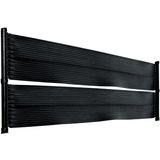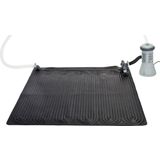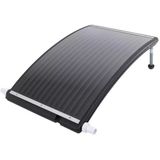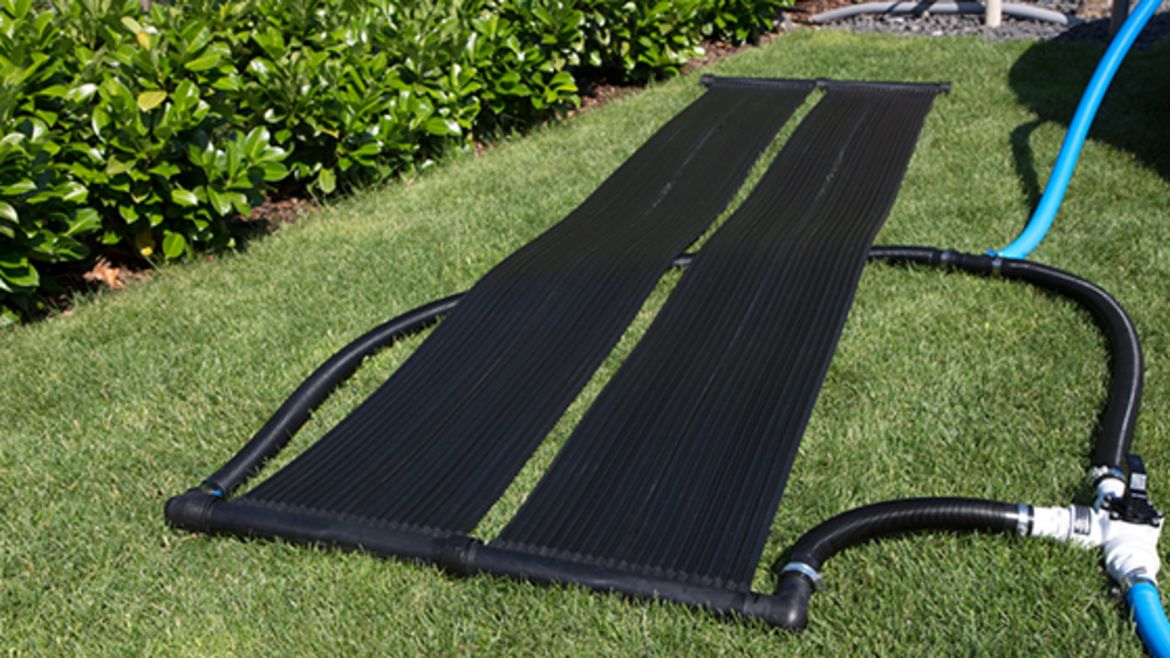Solar Pool Heating - Solar Collectors for Pool Water Temperatures of 30°C and More!
Solar energy to heat your pool: advantages and disadvantages
Solar energy is an economical and environmentally friendly way to heat your pool water. Let's take a look at the pros and cons of solar collectors for pool heating:
Pros:
- very effective way to heat pool water in good weather with a lot of sunshine
- many models of solar collectors are available at low prices
- maintenance costs are very low to none, depending on the circumstances
- best heating results when combined with a pool heat pump
- suitable for extending the pool season
Cons:
- very low performance when it is very cloudy
- the back pressure affects the performance of the pool filter system
- take up a lot of space
- for solar collectors that are mounted on the garage or the roof of the house: strong back pressure and higher power consumption compared to solar pool heaters on the ground
Solar pool heating can be very effective when used properly. Note, however, that this is only true if your solar collectors are large enough.
Solar pool heating: more is better!
If you want a heated pool on more than just hot midsummer days, we strongly recommend that you size your solar panels appropriately. You have to take into account that water can store a lot of heat. Conversely, this means that pool water is difficult to heat up. To make matters more complicated, we are not talking about heating up a couple of litres of water - it's usually thousands or even tens of thousands of litres! It is important to keep in mind that a solar pool heater faces a mammoth task if it is to increase the water temperature in your pool noticeably. It requires a large amount of energy. Which is why you will only get good results if you size your solar collectors appropriately for your pool size.
What does the sun do?
It is very important to be able to estimate how the sun's energy affects your pool and the solar panels. Irrespective of the ambient temperature, the sun radiates between 900-1,200 watts of gross energy per square meter when the sun is high in a cloudless sky in summer. Objects absorb different amounts of heat depending on their surface area, material and colour. You should subtract 20-60% of radiation from the theoretical gross value. A pool itself can absorb around 40-55% of the sun's energy (because the light is refracted several times in the water) while solar collectors absorb around 70-80%. However, even light clouds or light shadows quickly reduce solar radiation by 30-60%. Very strong shadows or intense clouds cause the performance to drop by up to 95%!
The key points to consider in a solar pool heater
Let's assume that your pool has a surface area of 12m². The surface area of the side walls of the pool should also be taken into account (you can assume an efficiency of 20 to 30% here). On a very sunny and cloudless day, you can expect a net solar radiation of 6-8 KW including the side walls. If you were to connect a solar pool heater with a surface area of 0.34m² (such as the Steinbach Solar Snail), it would add another 300 W. That's good but hardly noticeable. If it is slightly cloudy, the solar radiation absorbed by the pool itself drops to 3-4kW while the Solar Snail would only provide 150 W. With an efficiency of approx. 80%, this is simply not enough to heat your pool noticeably.
Our recommendations for warm pool water
On really sunny days, the water in the pool can reach 28°C on its own. Your solar heating should be able to achieve more than 30°C on good days and about 26°C on mediocre days. As mentioned earlier, a swimming pool has a large surface area and therefore absorbs a significant amount of energy from the sun. You should also take into account the energy absorbed by the side walls of an above ground pool. However, if your solar collectors are undersized, the overall effect on your pool water temperature will simply not be significant.
A good solar pool heater does not have to be expensive!
The good news is that you can do a lot even with a relatively small budget. Solar mats, in particular, are a type of solar collector that give you a large collector area at a reasonable price. Although these are not quite as efficient as solar snails, they offer significantly more collector area for a comparable amount of money. Let's stay with our previous example: If you go with a Steinbach Speedsolar Solar Mat 0.7 x 3.0 m, you get an impressive 2.1 m² of surface area. If it is not angled, the efficiency will drop to around 70%, but the large area will still give a huge amount of energy.
Comparison of the absolute heat output between Steinbach solar mat and solar snail
Under ideal conditions, the following performance can be achieved:
- Solar snail: 300 W
- Solar mat 0.7 x 3.0 m (optimally angled): 1,750 W
- Solar mat 0.7 x 3.0 m (not angled): 1,570 watts
With slightly cloudy weather:
- Solar snail: 150 watts
- Solar mat 0.7 x 3.0 m (optimally angled): 870 watts
- Solar mat 0.7 x 3.0 m (not angled): 780 W
Let's compare that with the pool's natural heat absorption. Under ideal circumstances, this is a maximum of 8,000 W and with a little cloud cover, a maximum of 4,000 W. While the effect of a solar snail is barely noticeable, the yield from solar mats is siginificant. And that too, for a manageable amount of money.
So how much collector area do you really need?
We refer to the recommendations of the pool expert Benjamin Garherrs, who makes the following general recommendation in his article about solar pool heaters :
- For pools up to 80 cm water depth, the collector area = 18-20% of the water surface area
- For pools up to 100 cm water depth, the collector area = 25% of the water surface area
- For pools with more than 100 cm water depth, the collector area = 30-35% of the water surface area
Note: These numbers are intended as a rough guide. Poorly insulated pools, uninsulated pools, or pools that get a lot of shade, will need larger solar collector areas.
Solar pool heating: How to calculate the right size with an example
Let's consider the 366 pool with a water depth of 90 cm. As per the recommendation above, the collector area needed would be 25% of the water surface area. Here we refer specifically to the water surface area and not the pool surface area. You could use the pool surface area to base your calculations, but we would like to determine the minimum necessary.
Calculating the pool surface
Our 366 pool is a frame pool and has a net surface of 346 cm. We use the formula: π*r² with r as 1.73 which gives us a surface area of approximately 9.4m²
Dimensioning of the solar pool heating based on the pool surface
⇒ 25% of 9.4m² = 2.35m² collector area ⇒ this is the minimum required. Earlier we mentioned the Steinbach solar mat with a base area of 2.1m². This is slightly lesss than the minimum required. But since the difference is only 10%, it is acceptable. Or, you could supplement it with an Intex or Bestway solar mat and with their additional 1.44m² surface area, you will have the following ⇒ 2.1m² (Steinbach solar heating) + 1.44m² (Intex solar mat) = approx. 3.5 m² total surface area.
Comparison: How you can influence the water temperature
Using this setup, with 3.5m² collector area, you can achive an input of about 3,100 W on very good days. With light clouds you can expect about 1,550 W. This is definitely worth the investment and will help you crack the 30°C mark noticeably on a few days. But a water temperature of 30°C is not feasible with this setup on not so good days or with cooler air temperatures.
More is not enough?
In moderate temperatures, you will need an estimated 5,000-8,000 W of heat energy over the course of the day to bring your pool water to a temperature of 30°C or above. If there are many hours of sunshine with clear skies, this can be easily achieved with solar mats in our example. But if the sun doesn't shine all day long at the best angle, the total energy input will drop significantly. Let's take a 21°C day in the middle of August as an example. The duration of direct sunshine is shorter and the angle of the sun is lower. A few clouds here and there over the course of the day will reduce the amount of energy entering the pool water. We can estimate the following: energy absorbed by the pool: 2,200 W x 11 hours energy provided by the solar heating ( 2.1m² collector area => 1,100 W x 11 hours total input: 3,300 W (x 11 hours) That's just not enough for 30°C under these circumstances. Not even for 28°C. Especially not when pools tend to cool off for longer sue to longer nights.
The optimal setup for solar pool heating:
If you want to have higher water temperatures on less than ideal days, you will have to install more solar panels and insulate your pool well. Because the cooler air temperatures and windier conditions will lead to increased heat loss. The goal here will be to expand your existing solar collector area and optimise thermal insulation on your pool.
a) Thermal insulation
Even if you feed significantly more heat into your pool you will still have trouble keeping your pool water warm if your pool is not insulated. You can take the following measures to reduce heat loss:
- use a solar pool cover. This gives you great results at a low price.
- place insulating products such as pool mats or even XPS panels under your pool. Note that XPS panels are not easy to install and should be protected from pressure points loads with click vinyl.
- you can insulate the walls of a steel wall pool with a 2 cm layer of styrofoam which will significantly reduce the heat lost through the walls
- You can also use a transparent pool cover such as the Cabrio Dome.
Combine two (or more) of these measures for better results. One measure alone will not be enough to extend the pool season noticeably.
b) More solar collectors
You can extend your pool use season by a few extra days and enjoy heater pool water with just 25% of the collector area. Good thermal insulation will add a few more days. But if you want to enjoy warm pool water even on less than ideal days and cooler days, then 25% will not be enough - it will have to be 50 to 120%. 50% may suffice for pools with a water depth of less than 80 cm but pools with a water depth of 150 cm would require 120%.
What are the advantages of an even larger solar heating?
Let's recalculate the surface area for our example. We assumed a less than ideal August day and estimated the heat input to the pool to be 2,200 W. If we now resize the solar pool heating to cover 80% of the water surface, then we would arrive at a collector area of about 7.5 m². ⇒ the estimated heat output would be around 3,900 W from the solar collectors alone. Add to that the 2,200 W energy absorbed the pool itself and you will get around 6,100 W. That should definitely be enough for temperatures of 28-32°C! But you have to keep in mind that even this will not be enough with shortening days, decreasing air temperatures and bad weather. Supplementing your setup with a powerful heat pump will be necessary at an ambient temperature of 12°C and overcast skies. That's because the heat input can go down by 95% under these circumstances!
Solar pool heating: what to expect
There are only a few days during a normal summer in central Europe when pool water will reach temperatures of 28°C or even 30°C on its own without an additional source of heat. If you have a solar heating system of the minimum size required for your pool, that will be enough to give you a pool water temperature of 28°C to 30°C on a few additional days. Insulating your pool will add a few more days and will also help your pool water heat up faster. However, not even a generously sized solar pool heater can work wonders on cloudy or cold days.
Advice on buying solar collectors
We always have interesting offers - with speedy shipping, of course. Here are a few of the solar collectors in our range:
- Steinbach Speedsolar Solar Collector: maximum efficiency per collector surface; however, only a small collector area. Ideal when you have very little space and want maximum yield.
- Steinbach Speedsolar Solar Mat: Available in different sizes. Such a solar collector offers a lot of collector area for the money spent. A very good choice if you have plenty of space and have a limited budget.
- Intex Solar Mat: Very economical. This solar heater has a floor area of approx. 1.44m². It is perfect for forming clusters of 4, 6 or 8 pieces which will collect a large amount of solar energy. Disadvantage: the quality is rather low.
- Steinbach Solar Collector Exclusive: This is our bestselling solar collector. It features a chic design and is very well made. This solar collector offers a collector area of about 0.8 m². This is great choice if the aesthetics and high quality are important to you and you are willing to pay more than you would for comparable solar mats.
Related products
-
 5.0 (6)
5.0 (6)Steinbach Speedsolar Solar Collector, Set of 2 incl. connections and pipes
-11%- Max. flow rate: 7,500 L/h
- Water capacity of the collector: 5 litres
- Dimensions: 58 x 58 x 33 cm
€ 288,99 € 324,42Not available at the moment
-
 4.7 (20)
4.7 (20)Steinbach Speedsolar Solar Mat, 0.7 x 3.0m
-24%- Easy to install
- LDPE plastic
- Flow rate 10,000 L/h
€ 98,99 € 130,99Delivery by January 02
-
 € 24,99 € 35,49
€ 24,99 € 35,49Delivery by January 02
-
 4.5 (36)
4.5 (36)Steinbach Solar Collector Exklusiv, 1 Piece
- Max. flow rate: 10,000 L/h | 10 m³/h
- Collector water capacity: 12 litres
- Dimensions: 110 x 69 x 14 cm
€ 148,99Delivery by January 02

